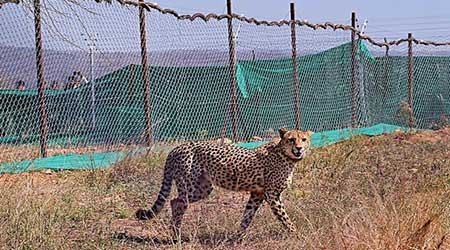Date : 30/05/2023
Relevance: GS-3: Conservation, environmental pollution and degradation, environmental impact assessment.
Key Phrases: Cheetahs, Kuno National Park, Institute for Zoo and Wildlife Research, Spatial Planning, South Africa, Maasai Mara, Namibia, Ecological Imbalances, Farmer-Cheetah Conflicts.
Context:
- The ideal density of cheetahs in an unfenced area is one per 100 square kilometres; however, the density of cheetahs in the Kuno National Park is three per 100 square kilometres.
Introduction:
- After nearly seven decades of extinction in India, the Asiatic cheetah
has been reintroduced in the Kuno National Park in Madhya Pradesh.
- The aim was to establish a free-ranging population of this magnificent species.
- However, a recent study by scientists from the Leibniz Institute for Zoo and Wildlife Research highlights serious shortcomings in the reintroduction plan.
- This article examines the concerns raised by the scientists and the implications for the success of cheetah reintroduction in India.
Why Reintroduce The Cheetah To India?
- Just as the tiger is the flagship species of the forest, the cheetah is the flagship species of the grasslands, scrublands and open forests.
- Therefore, with the reintroduction of the cheetah, these dryland
ecosystems of India will have a chance to return to their natural state.
- Being a top carnivore, the cheetah is a major evolutionary force that shapes ecosystem functions and enhances species diversity.
The Cheetahs is Part Of Our Heritage:-
- It’s the only large mammal that has been declared extinct in India in recent history.
- It is extensively mentioned in Indian literature, with the word ‘cheetah’ itself originating from the Sanskrit word ‘chitraka which means ‘speckled one’.
- Indian rulers, especially the Mughals, kept cheetahs as pets and used them for hunting. Emperor Akbar, for example, maintained a stable of over one thousand cheetahs.
- “I hunted for two or three days in those desert plains... and hunted with cheetahs many antelopes.”(Emperor Jahangir,The Tuzuk-i-Jahangir)
Inadequate Spatial Planning:
- The reintroduction of cheetahs in Kuno National Park raises concerns regarding the spatial organization of these animals.
- The researchers argue that the current plan, which allows for three cheetahs per 100 sq km, deviates from the observed cheetah densities in other free-ranging populations.
- Typically, cheetah densities are much lower, with only one cheetah per 100 sq km in prey-rich areas such as the Maasai Mara in Kenya.
Socio-Spatial Organization of Cheetahs
- The study highlights the socio-spatial organization of cheetahs, particularly the distinct spatial tactics employed by adult male cheetahs. Male cheetahs establish territories with a separation distance of 20-23 km.
- However, the introduction of three male cheetahs from Namibia may result in the occupation of the entire national park, leaving no space for additional males from South Africa.
- Consequently, male cheetahs from South Africa will be forced to settle outside the park, potentially leading to conflicts with humans and livestock.
Exploration Phase and Farmer-Cheetah Conflicts
- During the exploration phase after translocation, reintroduced cheetahs tend to undertake extensive forays over a vast area.
- The researchers predict that the cheetahs introduced in Kuno National
Park may move outside the park during this phase, increasing the
likelihood of conflicts with livestock farmers.
- This poses a significant challenge to the successful establishment of cheetah populations in India.
Implications for Future Reintroduction Plans
- The scientists argue that considering the socio-spatial organization of cheetahs is crucial if India plans to establish a meta-population by introducing cheetahs in multiple parks.
- Proactive measures should be taken to address farmer-cheetah conflicts and enhance our understanding of cheetahs' territorial establishment in new areas.
- Predictive approaches can play a vital role in assessing the success of future trans-continental introductions and minimizing conflicts between humans and cheetahs.
Conclusion
- The reintroduction of cheetahs in India holds great promise for conservation efforts and biodiversity restoration. However, the recent study highlights the need for a careful and well-informed approach in the spatial planning of cheetah populations.
- To ensure the success of reintroduction programs, it is crucial to consider the socio-spatial organization of cheetahs, address potential conflicts with local communities, and gather valuable knowledge for future reintroduction initiatives.
- By adopting a proactive and scientifically guided approach, India can pave the way for the conservation and thriving of the magnificent Asiatic cheetahs in its landscapes.
Source: The Hindu
Mains Question:
Q. "Discuss the implications of the higher density of cheetahs in Kuno National Park and the need for balancing conservation goals with ecological considerations. Critically analyze the reintroduction plan and its impact on the cheetah population. (250 words).







